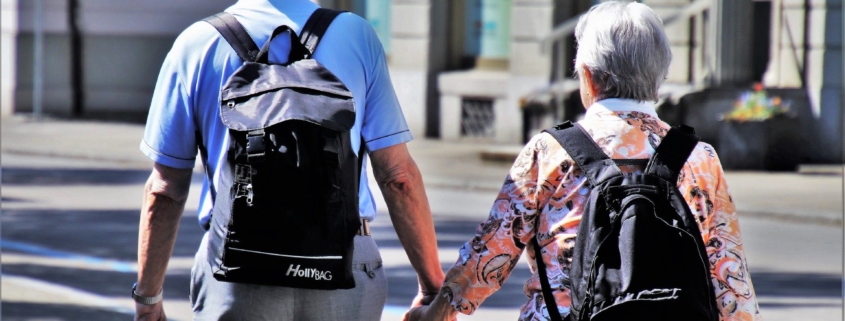Physical distancing, social cohesion
2020 will probably be remembered as the year of the COVID-19 global pandemic. The whole world has paused in horror watching the virus spread. Fear, uncertainty and often misinformation followed in its wake. COVID-19 has affected our lives at every level. Our social and family lives, our careers and even our physical and mental well-being have been impacted. As the initial shock subsided, we had to content with redefining a new “normal” for our lives and adjusting to it.
Times of crisis tend to have a peculiar effect on people and societies. They often act as amplifiers, amplifying the good along with the bad. Fear, inequities and systemic issues are amplified along with kindness, courage and social cohesion. The dramatic changes brought by COVID-19 can disproportionally affect older adults and their caregivers. Older adults have to content with social isolation and fear for their health. Furthermore, pervasive ageist attitudes affecting healthcare provision can limit older adults’ access to care which is often reserved for younger people. At the same time, caregivers can feel powerless since physical distancing guidelines may prevent them from being close to their loved ones. They also have to content with their own fears and uncertainty while managing the fear of their loved ones.
The most common way to stop a virus from spreading is ensuring that people are not in close proximity with each other. This very important public health measure has been named “social distancing”. While the measure itself is necessary the term used to describe it is somewhat unfortunate. While staying physically apart from each other to combat the spread of the virus we should come closer to each other in a deeper way. We should communicate more, care more and empathize more with each other. In essence we should become more social while maintaining physical distance. As humans we crave contact and closeness so we must make up for the lack of physical closeness by focusing on our communication with each other.
The first step towards effective communication is recognizing our own feelings even if they are scary or perplexing. Honest discussions about our feelings, which will probably include fear and uncertainty, can help us and our loved ones. More importantly they can help us understand that we are all in this together and dealing with the same issues. Communication however should not be limited to discussing unpleasant feelings. We all enjoy having fun with our friends and family and nowadays technology can help us spend quality time together even when we are apart. Including virtual get-togethers with friends and family in our daily schedule can help us overcome loneliness and improve our mood and well-being. It’s a good time to get creative! Virtual book clubs, board games nights or tea breaks not only bring us closer to our loved ones but they also add some structure to our daily life. More importantly, they reaffirm our ability to control our lives even during times of crisis.
Retaining control of our lives means retaining all those things we enjoy. Maintaining our daily schedule (as much as possible) and continuing to invest time in what we enjoy is crucial. We must rethink our hobbies and favorite activities in light of the necessary public health measures but this doesn’t mean we can’t engage in them. We should think out of the box and change the way we engage with them. From focusing on those aspects of them that can be done safely to using technology to make up for the physical distancing, we can redefine them and explore aspects of them we hadn’t considered before. Perhaps we will come out of this crisis with new ideas, skills or interests.
Our world may still feel scary and uncertain but remember that we can stay informed without succumbing to panic, we can be close to each other even when we are miles apart, we can change our habits while retaining what defines ourselves and, most importantly, we can keep each other safe and loved through this crisis.
What can I do?
- As an older adult: Reach out to friends and family. Your fears and concerns are valid and there are people who want to be close to you and help you through these difficult times. Try to maintain a daily schedule that includes mentally challenging activities and physical exercise. Stay informed and follow all safety guidelines. If safety guidelines feel overwhelming, try to integrate them in your daily routine and use visual cues and reminders. Monitor your health and contact your doctor if you have any concerns.
- As a relative: Communicate honestly with your loved ones. Be open about your fears and acknowledge their concerns. At the same time provide reassurance and practical assistance whenever possible. Use technology to connect with friends and family and assist older adults in the use of technology for communication. Promote exercise and contact with nature in a safe manner. Dancing to a favorite song or watching the birds in the garden can be a welcome break and a boost to mental and physical health.
- As an assisted living / nursing home owner: Ensure that residents can communicate with loved ones through the use of technology. Offer activities that promote physical exercise in a safe manner. Inform residents about upcoming changes in their daily lives and explain why these changes are necessary for their well-being. Implement regular health monitoring for residents and staff.
Resources
- Self-care advice for older adults: https://www.apa.org/news/apa/2020/03/self-care-older-adults
- Practical advice for older adults and caregivers: https://www.healthinaging.org/a-z-topic/covid19/unique
- Dementia specific practical advice for COVID-19: https://www.alz.org/help-support/caregiving/coronavirus-(covid-19)-tips-for-dementia-care



